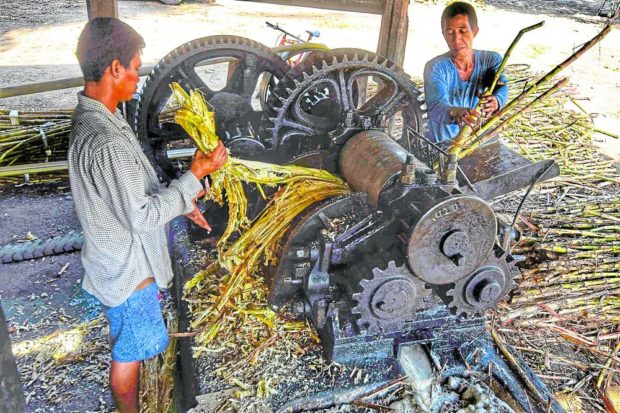
Other sweets and native delicacies at Barangay Imbalbalatong in Pozorrubio, Pangasinan, starts with the extraction of sugarcane juice using the big iron rollers of the “darapilan” (sugar mill) set up in village backyards. (Photo by WILLIE LOMIBAO / Inquirer Northern Luzon)
POZORRUBIO, Pangasinan, Philippines — Even from a mile away, the sweet aroma of caramelized sugarcane juice fills the humid air at Barangay Imbalbalatong in this eastern Pangasinan town.
Deep in the farming village, many residents tirelessly stir the boiling cane extract in a cauldron until it is thick enough and becomes syrup before pouring it into coconut shells where it hardens into “panutsa” (cooked brown sugar).
One of them is Joselito Omilda Sr., 50, whose family’s main source of livelihood revolves around the sugar industry, an age-old local trade that thrives right inside the villagers’ backyards, where they put up their own “darapilan” (sugar mill).
Also called “sinakob” in the Ilocos provinces and “dameg” in Pangasinan, panutsa can last for months, even years, Omilda told the Inquirer in a recent interview.
From September to May, carabao-pulled carts carry newly harvested sugarcanes to the five backyard darapilan in the village.
There, workers feed the canes into a mechanized miller, which squeezes the juice that flows into big vats atop makeshift stoves.
BACKBREAKING JOB | The traditional method of making “panutsa” (cooked brown or unrefined sugar) (Photo by WILLIE LOMIBAO / Inquirer Northern Luzon)
Self-supporting industry
Omilda, who has been working in the darapilan for years, says making panutsa involves an hour of boiling and half an hour of constant stirring to achieve a certain consistency and become caramelized.
The villagers have been engaged in sugar milling for decades, Imbalbalatong village chief Roger Obra, said in a separate interview.
“It’s sort of a self-supporting industry as the sugarcane is grown by local farmers themselves and the workers come from the barangay,” Obra said.
The village’s name comes from the word “balatong” (monggo/munggo or mung beans) and may be a misnomer as the farmers there no longer grow monggo.
“There was a time when we grew plenty of monggo, but quarrying activities in the river deepened the bed and made it difficult to source water for irrigation. So the residents shifted to growing sugarcane and cassava,” Obra said.
The traditional method of making “panutsa” (cooked brown or unrefined sugar) (Photo by WILLIE LOMIBAO / Inquirer Northern Luzon)
Family affair
For some villagers, sugar milling is a family affair and a shared responsibility, as proven by the Omilda family.
The Omilda patriarch is a tenant of a sugarcane farm, while his wife, Shirley, 55, and their two young children help in other chores at the darapilan, such as cooking the juice, using bagasse (dry sugarcane bark) as fuel.
They would wait for about an hour as the juice created a mini waterfall inside the vat. When the white juice turns reddish, they continually stir the scorching hot syrup.When the consistency is right, they pour the sticky syrup into coconut shells, which explains the cone shape of the panutsa, which is also used to sweeten different kinds of “kakanin,” or rice cake.
Apart from panutsa, sweet glutinous rice wrapped in woven coconut leaves is being churned out of the darapilan.
Called “patupat,” the sticky rice delicacy also takes around one and a half hours to cook and sweeten, said Nazario Bernabe, 60, who, together with his wife Imelda, 56, had been producing patupat for 35 years.
“Minana pa namin ito sa aming ninuno (We inherited this from our forefathers),” Bernabe said of the business that helped them send their two children, now both adults and employed, to school.
According to Imelda, making patupat starts with weaving the coconut fronds (without the midrib) into packets.
After washing and soaking the glutinous rice for 15 minutes, it is placed inside the packets, which are then arranged inside a bamboo basket and covered entirely with a plastic net.
The baskets are submerged in the vats of boiling sugarcane juice until the patupat are cooked.
TEAMWORK | Farmworkers harvest sugarcane in a field in Pozorrubio for use in “patupat” and “panutsa” making. (Photo by WILLIE LOMIBAO / Inquirer Northern Luzon)
Tedious work
After a short while, the cooked patupat are placed in basins and allowed to cool down. The thick syrup left in the vat is brushed on the patupat to further enhance the native delicacy’s sweetness.
“Sadly, there are only three families in the village who continue to produce patupat,” lamented Bernabe.
“There used to be more, but the children no longer want the tedious work,” he added
Even the couple’s children have turned their backs on the industry and have found work elsewhere.
They are hoping that the darapilan will endure when technology is fast replacing the old practices, such as the sugar mills being powered by carabaos.
The mills are now mechanized, but still as environmentally friendly as they can be, and the panutsa is still pure unrefined sugar with nothing added, not even water.
The sugarcane barks are not wasted as these are used as fuel, and the ash is sold as fertilizer.
Six sugar mills in Imbalbalatong and seven in neighboring Barangay Buneg are still fully operational, and the patupat they produce is the reason for the town’s annual Patupat Festival.
Unfortunately, this year’s festival was shelved by the local government, Bernabe said.
But mill operators are hopeful that as long as sweet-toothed Filipinos love kakanin, the darapilan will survive to produce their beloved panutsa and patupat.